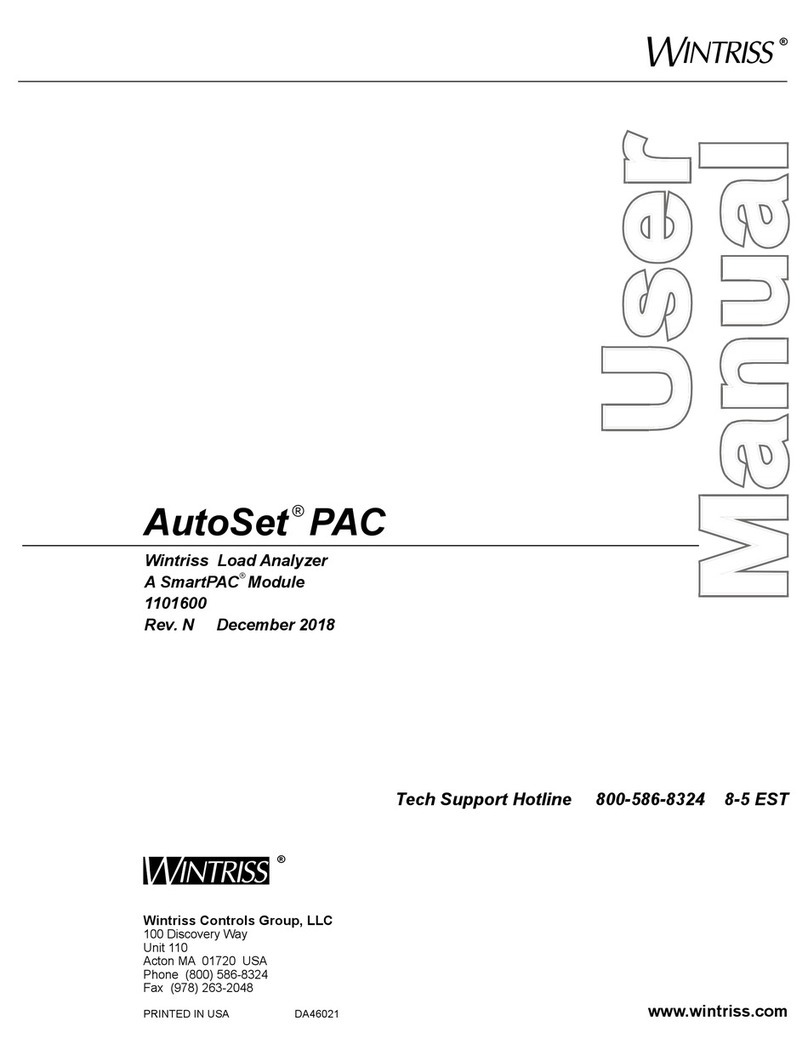
AutoSet User Manual 1137200
Table of Contents iii
Appendix A. Wiring and Settings Tables. . . . . . . . . . . . . . . . . . . . .A-1
Glossary . . . . . . . . . . . . . . . . . . . . . . . . . . . . . . . . . . . . . . . . . . G-1
Index . . . . . . . . . . . . . . . . . . . . . . . . . . . . . . . . . . . . . . . . . . . I-1
Wintriss Manuals . . . . . . . . . . . . . . . . . . . . . . . . . . . . . . . . . . . . . . . . . -1
List of Figures
Figure 1-1. AutoSet 1500 Front Panel ..............................................................................................1-3
Figure 1-2. AutoSet 1504 Plus Front Panel ......................................................................................1-3
Figure 2-1. AutoSet 1500 Mounting Dimensions .............................................................................2-2
Figure 2-2. AutoSet 1504 Mounting Dimensions .............................................................................2-2
Figure 2-3. AutoSet Panel Mount: Mounting and Cutout Dimensions ............................................2-4
Figure 2-4. AutoSet 1500 Processor Board: Location of Important Components ............................2-6
Figure 2-5. AutoSet 1504 Processor Board: Location of Important Components ............................2-7
Figure 2-6. AC Power Connections ..................................................................................................2-8
Figure 2-7. Correct Way To Make Terminal Block Connections ....................................................2-9
Figure 2-8. Strain Link: Mounting Dimensions ..............................................................................2-10
Figure 2-9. Strain Link Mounting Options on Gap-frame Presses .................................................2-11
Figure 2-10. Strain Link Mounting Options on Straight-side Presses ..............................................2-12
Figure 2-11. Strain Link Drill Jig: Mounting Dimensions ...............................................................2-13
Figure 2-12. Shield Drain Wire Connected to Ground Stud on Enclosure .......................................2-16
Figure 2-13. LMCS Installation ........................................................................................................2-18
Figure 2-14. AutoSet 1504 Processor Board: Mode Switch #2 Set to ON (Zero Cam Enabled) .....2-20
Figure 2-15. AutoSet 1504 Processor Board: Mode Switch #6 Set to OFF (AutoSet 1) .................2-24
Figure 3-1. Potentiometer Adjustment Screw on Strain Links without Access Hole in Cover ........3-2
Figure 3-2. AutoSet 1500 Calibration Kit Processor Board: Old Style ............................................3-6
Figure 3-3. AutoSet 1500 Calibration Kit Processor Board: New Style ..........................................3-7
Figure 3-4. Tonnage Dial Indicators: Old-style Board (Left), New-style Board (Right) .................3-9
Figure 3-5. Mode Switch #3 Set to “Decimal Point Off” Position (Old-style Processor Board) .....3-9
Figure 3-6. Load Cell Gain Adjustment Potentiometer with Adjustment Screw ...........................3-10
Figure 3-7. AutoSet 1504 Processor Board: Tonnage Dial Indicators ...........................................3-13
Figure 3-8. AutoSet 1504 Processor Board: Mode Switch #3 Set to OFF (Decimal Point On) .....3-14
Figure 3-9. AutoSet 1504 Processor Board: High/Low Gain Jumper and Gain Potentiometer .....3-16
Figure 3-10. AutoSet Label Showing Locations for Recording Calfactors and Jumper Settings ....3-19
Figure 4-1. Setpoint Calculation Example: Tonnage Produced at Each Strain Link ........................4-2
Figure 4-2. AutoSet 1504 Processor Board: Mode Switch #1 Set to OFF .......................................4-4
Figure 4-3. AutoSet 1504 Plus Processor Board: Percent High Tolerance Dial ..............................4-5
Figure 4-4. AutoSet 1504 Plus Processor Board: Percent Repeatability Dial ..................................4-7
Figure 4-5. AutoSet 1504 Plus Front Panel Showing Reverse Tonnage LED Displays ................4-13
Figure 4-6. AutoSet 1504 Processor Board: Mode Switch #7 Set to ON (2-Ch. Operation) .........4-14
Figure 5-1. AutoSet 1504 Plus Front Panel Displaying High Setpoint Faults ..................................5-2
Figure 5-2. AutoSet 1504 Plus Front Panel Displaying Repeatability Fault ....................................5-3
Figure 5-3. AutoSet 1504 Plus Front Panel Displaying High Setpoint and Repeatability Faults ....5-4




























